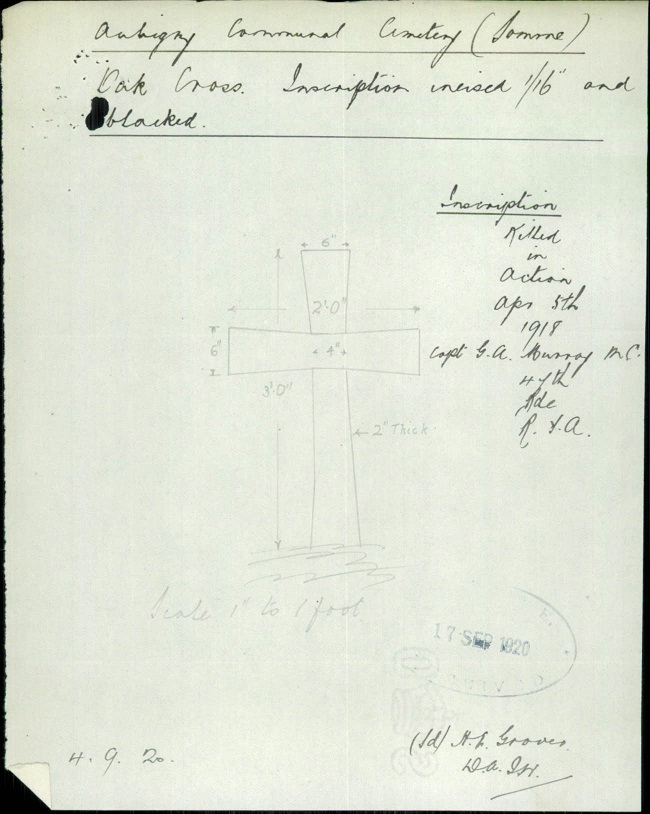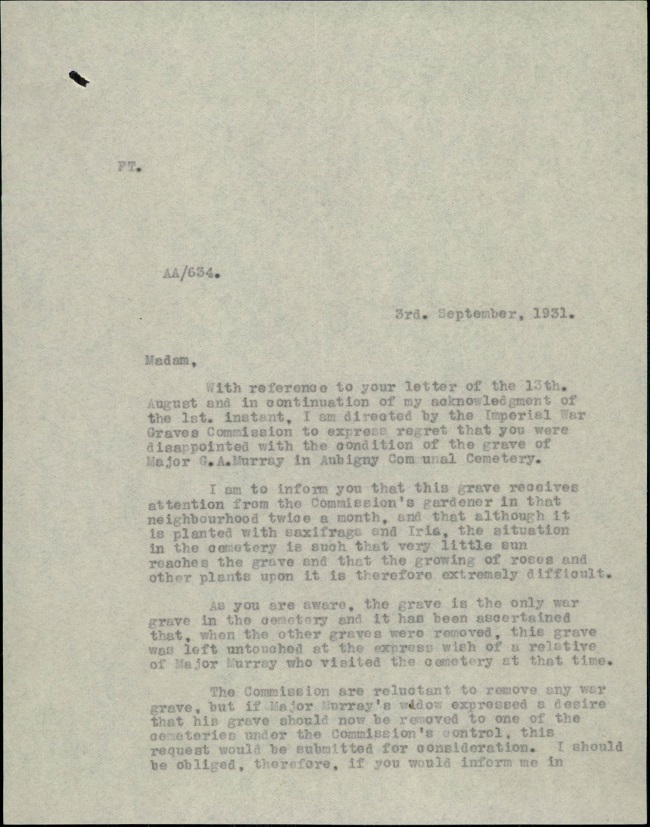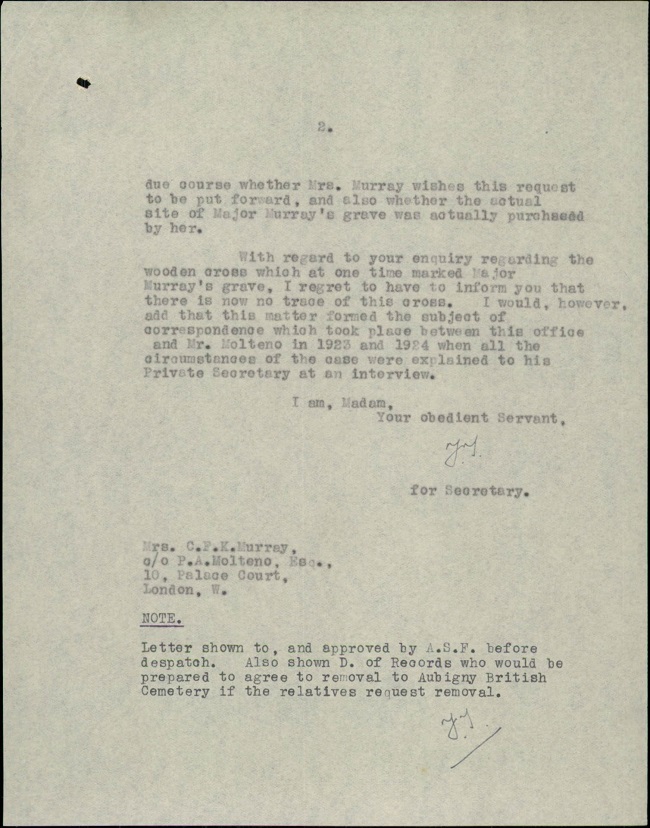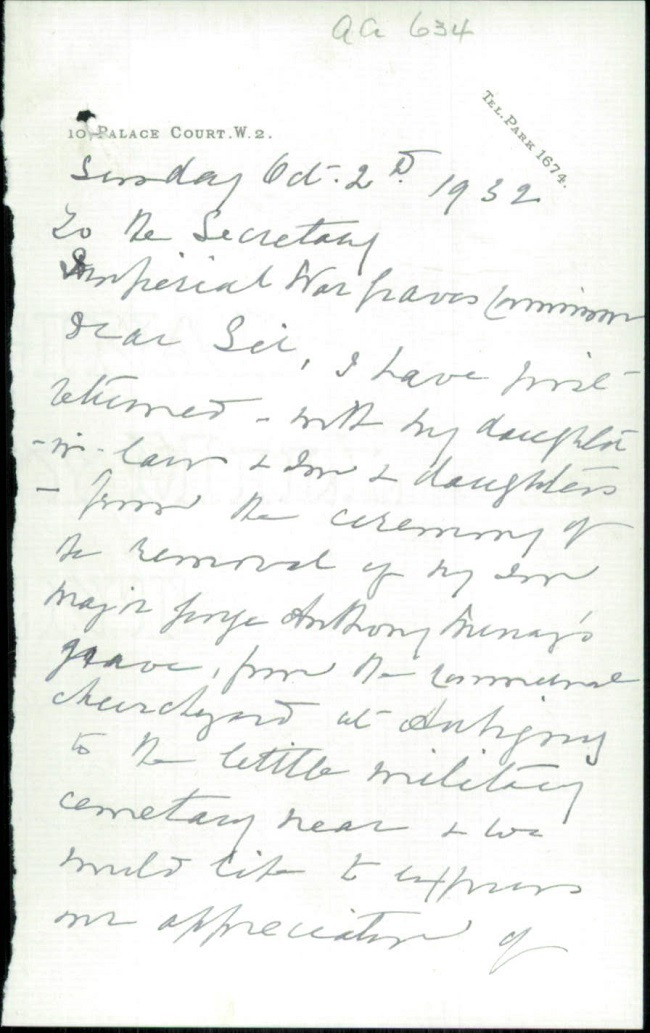Major George Anthony Murray
File reference: CWGC/8/1/4/1/1/2 AA634
Casualty Name(s): Major George Anthony Murray
Nationality: South African
Where buried: Aubigny British Cemetery

Major George Anthony Murray was born on 29th September 1893 in Cape Town, South Africa to Dr. Charles Frederick Kenman Murray, President of the South African Medical Association, and Caroline Murray, an advocate of suffrage for South African women. George was educated at Bedales and Trinity College, Cambridge, studying for the Natural Sciences Tripos.
At the outbreak of war in 1914, George opted to remain at Cambridge to complete the first part of the Tripos. During this time, he served in the Cambridge Officers Training Corps until the completion of his exams in May 1915 and was commissioned as a Second Lieutenant in the Royal Field Artillery in June. George arrived in France the following September and was despatched to an ammunition column in the 14th Division.
For his actions during the September offensive in 1916, George was awarded the MC. After returning from a brief period of home leave in January 1917 George was appointed Adjutant before being promoted to full Lieutenant; he was then posted to D Battery in September 1917, after recovering from an infection of boils, and promoted to the rank of Captain (Acting) in October of that year.
In January 1918, whilst on a Battery Commanders Course in Shoeburyness, George and Margaret (nee Molteno) married in Marylebone Presbyterian Church. Upon his return to the battery, amidst the German Spring Offensive, George was made Acting Major on 22nd March. Shortly thereafter, Margaret received a letter bearing the news that he had been badly wounded by a shell splinter and sent off to an Aid Post at Fouilly. Following a special enquiry from the War Office, the family were informed that George had died at a forward dressing station on 4th April 1918 and was subsequently buried in Aubigny Communal Cemetery.
In the spring of 1919, the Australian Graves Detachment removed 13 of the 14 war graves located in Aubigny Communal Cemetery to Adelaide British Cemetery. George’s grave, at the request of Margaret who intended to acquire a plot beside him, was the lone soldier left buried in Aubigny Communal Cemetery.
Correspondence between Margaret and the IWGC continued in the years that followed. In July 1920 she wrote to the Commission requesting that the words ‘Of South Africa’ be added to George’s headstone and that the wooden cross originally marking his grave, erected by his brother, be returned to the family in South Africa. While the addition of a personal inscription was easily arranged, the return of the wooden cross proved more difficult.

Subsequent enquires with the Graves Registration Units in France revealed that only one oak cross marked George’s grave, not two as Margaret had implied. The IWGC nevertheless noted that the cross was to be returned once a permanent headstone was erected in its place. Nearly three years later, following enquiries from Margaret in 1921, Dr. Charles F.K. Murray in April 1922, and the Office of the High Commissioner for the Union of South Africa in July 1923, a wooden cross was finally delivered to the family in South Africa.

Unfortunately, as the Commission were informed by Margaret’s father, P.A. Molteno, MP, the wrong cross had been delivered, that of Lieutenant G.A. Murray, Royal Engineers, who was buried in Marcoing Communal Cemetery. In spite of exhaustive enquiries, George’s cross, which had been lost in transport from Albert to St. Omer, could no longer be traced. The family were distressed and deeply disappointed to hear this news.

In 1931, following a visit to her son’s grave in Aubigny Communal Cemetery, Caroline Murray wrote to the IWGC expressing her displeasure with the condition of the cemetery, and reminded the IWGC of their past error involving the cross. Despite being the lone war grave in the cemetery, the Commission gardener was tending to the grave and planting flowers twice a month. The poor appearance was a consequence of the grave’s unfortunate position within the cemetery where little sun was received.


In light of the circumstances, the Commission proposed to remove the grave to the nearest war cemetery where its maintenance could be better ensured. Caroline and Margaret both agreed, requesting that the grave be transferred to Aubigny British Cemetery. The Commission was happy to oblige and to accommodate the family’s request to attend the exhumation and reburial services. Arrangements were made also with Captain J.R. Pitman, the IWGC Officer-in-Charge, to meet the family and for Reverend G.R. Milner to attend the reburial service to the great appreciation of the family.
On Thursday 29th September 1932, with Caroline, Margaret, and George’s siblings in attendance, George’s grave was transferred to Aubigny British Cemetery where he continues under the CWGC’s care today.


The above note of thanks reads: "we would like to express our appreciation of the reverent and sympathetic way in which all the arrangements were carried out. Our grateful thanks are due to the Commission for the help they have given us in arriving at a difficult decision and for their kindness and courtesy throughout".

